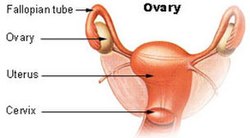Ovary
Ovaries (Singular: Ovary) are organs found in female organisms. Ovaries are part of the reproductive system needed to reproduce sexually.
| Ovary | |
|---|---|
 The ovaries form part of the female reproductive system, and attach to the fallopian tubes | |
 Blood supply of the human female reproductive organs. The left ovary is the oval shaped structure visible above the label "ovarian arteries". | |
| Details | |
| System | Female reproductive system |
| Artery | ovarian artery, uterine artery |
| Vein | ovarian vein |
| Nerve | ovarian plexus |
| Lymph | Paraaortic lymph node |
| Identifiers | |
| Latin | ovarium |
| MeSH | D010053 |
| TA | A09.1.01.001 |
| FMA | 7209 |
| Anatomical terminology | |
Most vertebrates have ovaries. Usually animals have two ovaries. Birds usually have only one working ovary; snakes have one ovary in front of the other. The ovaries are similar to testicles in men.
Anatomy
changeOvaries are shaped like eggs and are around 3 cm by 1.5 cm by 1.5 cm. The ovary is found in the side walls of the pelvis.
Each ovary is attached to the Fallopian tube. Usually each ovary takes turns releasing eggs every month.
Uses
changeOvaries have two purposes:
- Produce female sex hormones resulting in puberty
- Produce ova (also called "egg cells"), which are the female reproductive cells.
Menstruation
changeDuring menstruation, an ovum is released from the ovary and enters one of the Fallopian tubes. There, the ovum can be fertilised. Ovaries have a certain number of eggs in them, so when eggs stop being released, this is the start of the menopause. During this time, female hormones stop being produced.
Related pages
changeOther websites
change
| Endocrine system |
| Adrenal gland - Corpus luteum - Hypothalamus - Ovaries - Pancreas - Parathyroid gland - Pineal gland - Pituitary gland - Testes - Thyroid gland - Hormone |